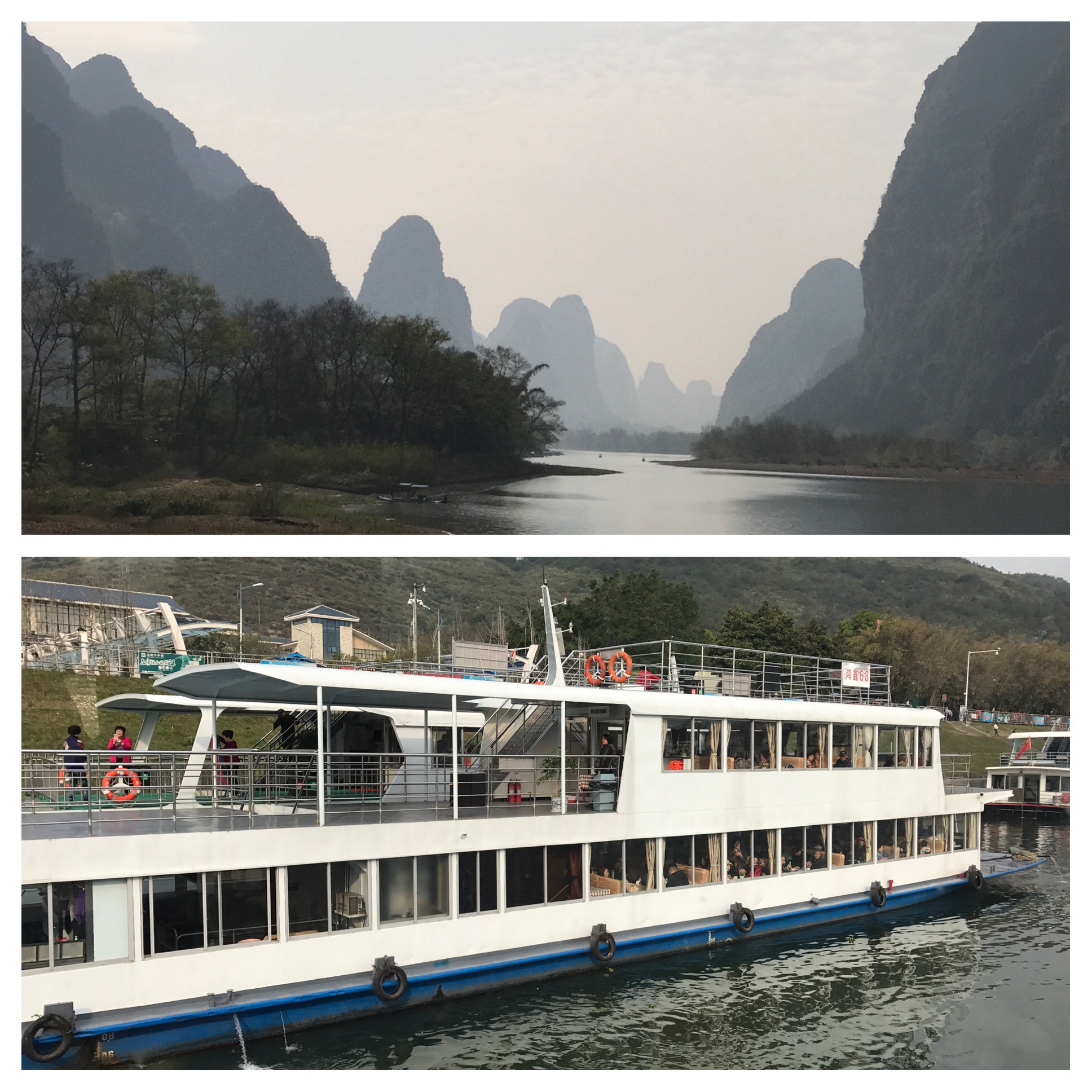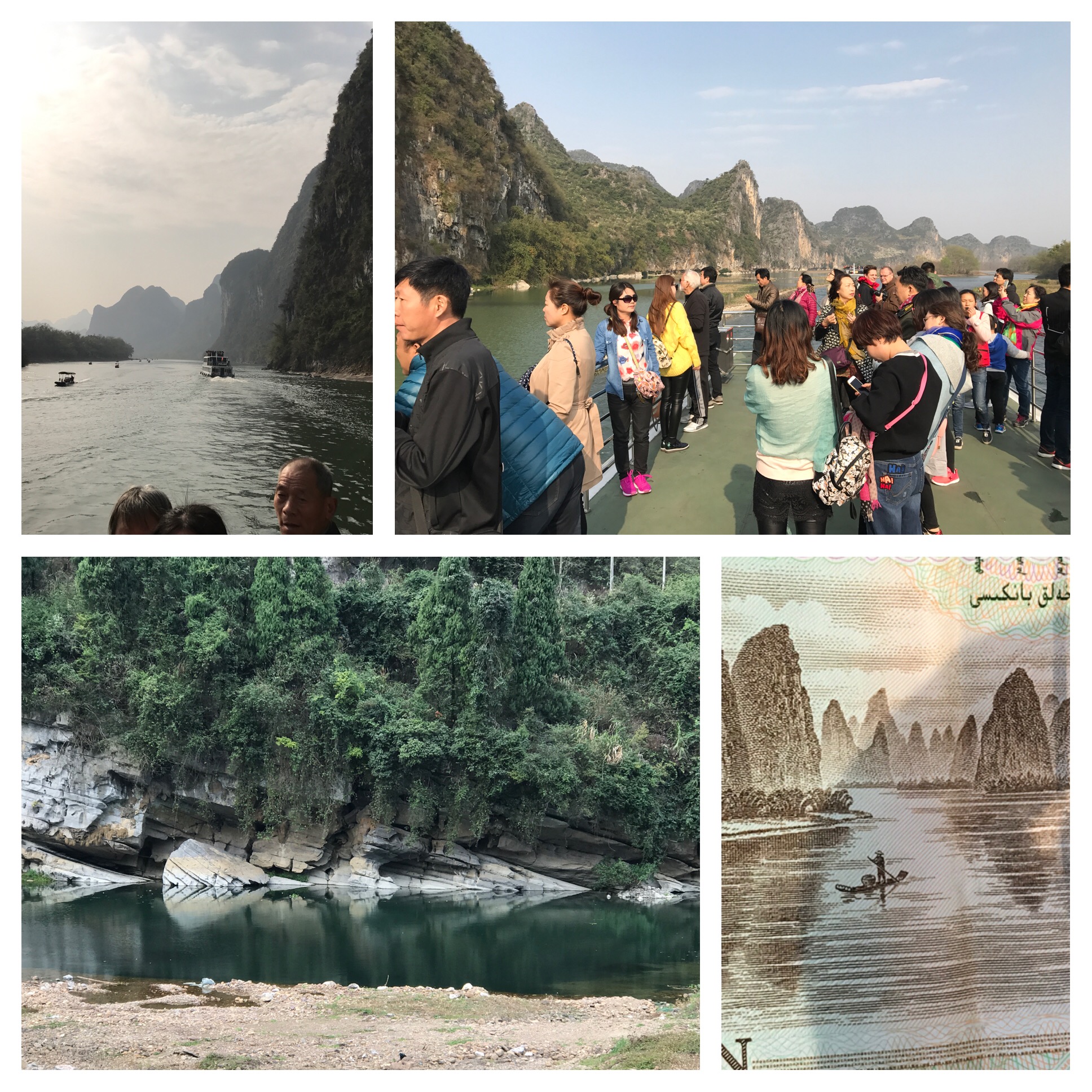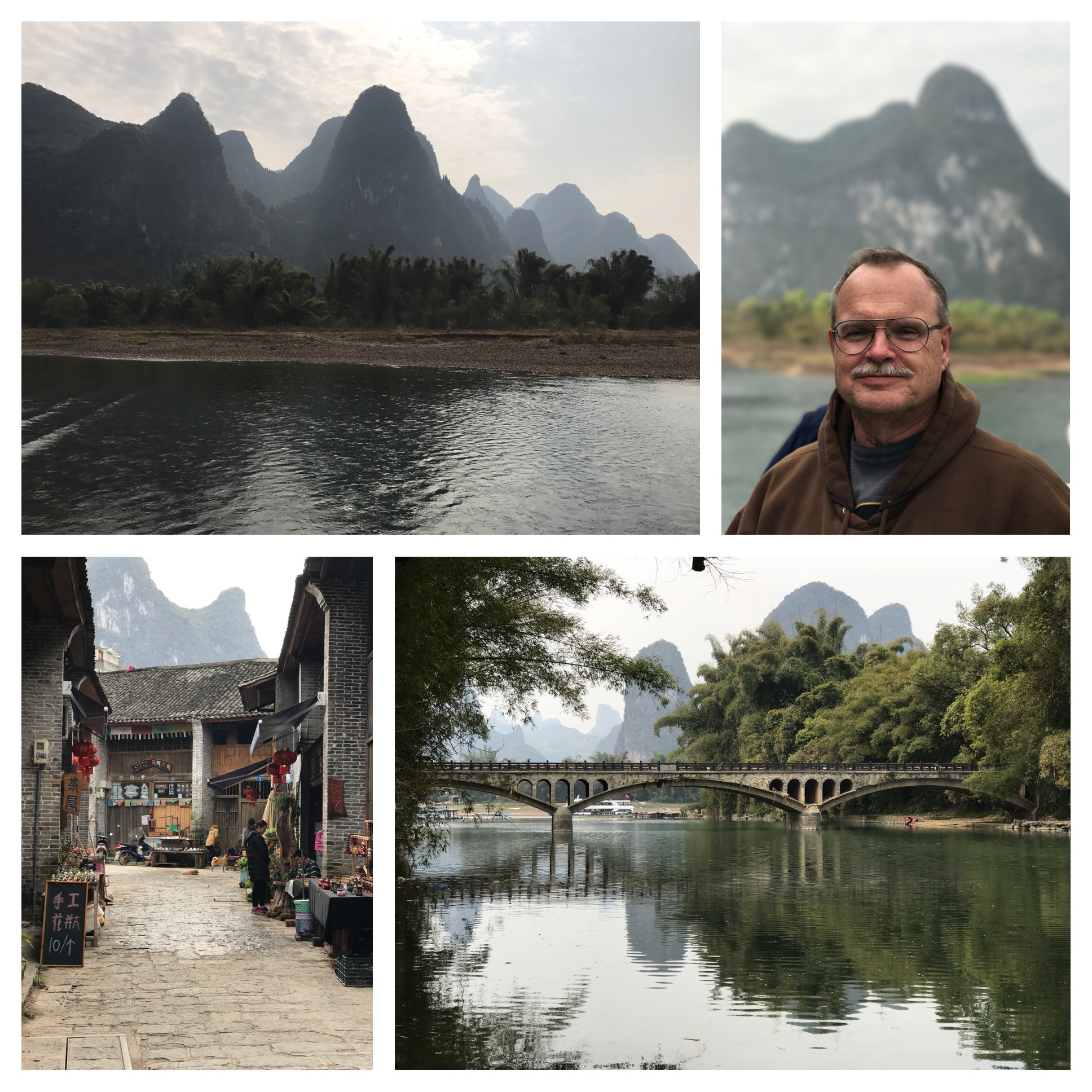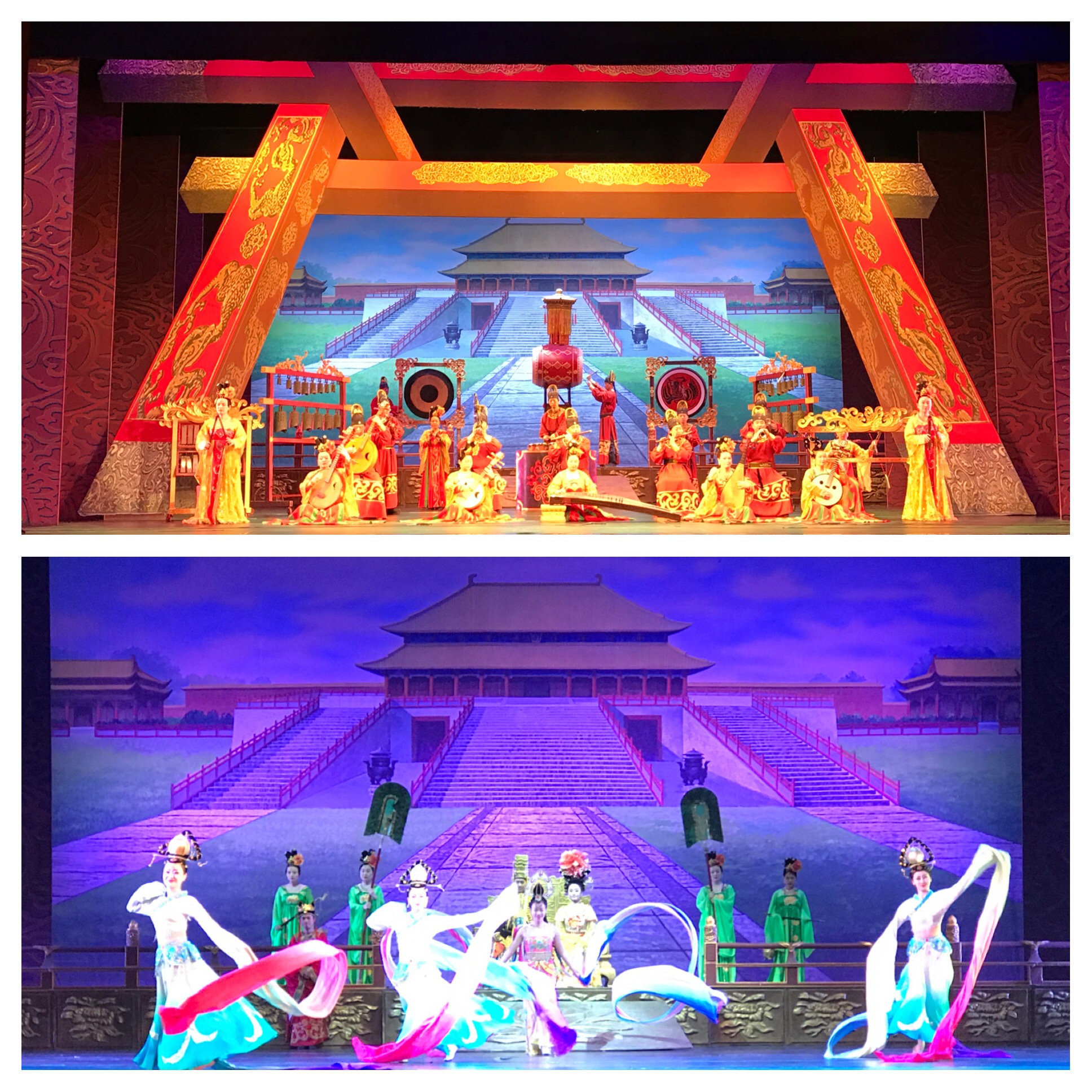


Day 57 of 111. The Li River, China
We were up early to pack our bags, have breakfast, and board the bus for our trip down a portion of the beautiful Li River. This region of China is somewhat rural and known for its natural beauty. The rock formations are limestone and have tall, craggy mounds covered with green. On the banks, we saw bamboo and evergreen trees. We also saw cows and water buffaloes used to work the land. The boat had several sitting rooms. Our tour took up one of the rooms. We had tables and benches where we could sip tea, but most of us spent our time on the back or top deck looking at the scenery. The weather was very pleasant ranging from cool to comfortably warm.
On the front of all of the Chinese paper money is an image of Chairman Mao. On the backside, however, are various images from around China. The back of the 20 Yuen note has a view from the Li River. It is called the “20 Yuen View”. Our guide had her wedding photos taken with that view in the background. We shared the boat with many Chinese tourists and we were all vying for spots to take pictures of the scenery and selfies with our friends. Fun.
The layers of hills was my favorite part of the scenery, but the views along the shore were also spectacular from time to time.
We got off the boat just after the 20 Yuen view and boarded a ferry to a small coastal town for a little shopping time and then a bus ride to the airport. We got back on the ship in Hong Kong.



Miscellaneous
In our Guilin hotel (the Shangri La Hotel) there is a mini-zoo with pigs, swans, peacocks, rabbits, roosters and ostriches. They had a lot of cute items for kids… I especially liked the bananas made into Minions. At night, the surrounding hills were lighted. One was lit with colored lights and another couple had white lights. They were pretty.
On one of our flights, I looked closely at the characters. From all three messages, I saw one character repeated. I guess that character must mean “seat”. A similar character might mean cushion.
Again, in the restrooms, there are two kinds of toilets. The way they were labeled vary from place to place. I thought it was pretty interesting.



Day 56 of 111. Guilin, China
We boarded an early flight in Xi’an and flew to Guilin in the southern portion of China. As soon as we left the terminal we could feel the warmer, more humid air. It was a nice change. Guilin is known for its natural beauty. The area is surrounded by limestone hills and mountains since this area used to be under the sea. Guilin is known for its small flowers that bloom in October. They are pretty, but also used for wine and tea. This area is good for growing rice and two of its local specialties are it rice noodles (with hot chilis) and the rice liquor. Some of the liquor is infused with snake (see the photo above) and has health benefits (no personal experience here). There are also varieties using spiders and scorpions. Yikes.
Ron posed on a bamboo raft with two cormorant birds that were used for fishing by the local population. In the background is Elephant Trunk Rock. Most of the mountains have caves that are used as cellars by the city.
On the way to lunch, we saw two beautiful pagodas in the lake. One is the sun pagoda and the other is the moon pagoda and are lit up at night. Next to the lunch restaurant was an artist’s studio with some stunning watercolors. Later we visited another park with Camel Rock. President Clinton made a speech in front of Camel Rock on his visit to China.
From our room window, we could see a beautiful sunset over the limestone hills.

Day 55 of 111. Tang Palace Dance Show, Xi’an, China
At the end of our day of amazing touring, we went to a dinner and show that recreated some of the opera of the Tang Dynasty (the peak of art and culture). The show had a variety of music and dance and was very entertaining. There were some instruments that I had never seen before. Our guide told us that Japan learned a lot from its contact with China whose cultural traditions were so advanced at such an early time. We were certainly ready for bed by the end of the evening.



Day 55 of 111. Terra Cotta Warriors and Horses Museum, Xi’an, China
The visit we were all waiting for was the visit to see the terra cotta warriors. In 1974, there was a drought and some of the farmers were digging several meters down to make a well. They found some pieces of terra cotta that came from a statue of a soldier. They reported this to the authorities and archeologists came in to follow up on the find. I’m sure they never expected to find this amazing army of warriors and horses. The area was turned into a museum and is organized into three “pits”. We visited Pit 3, then Pit 2, then Pit 1. Pit 3 is a small area that was apparently the command post for the army with high-ranking officials, but only a relatively small number of statues. We were able to see reconstructed statues in the pit and another area of individual pieces that are still being excavated. Pit 2 was mostly to show the excavation process, with few reconstructed warriors in the pits. Around the pit, however, were four great examples of warriors and a horse in class cases for viewing. There is a kneeling archer, a high-ranking general, a standing archer, and a soldier with his horse (seen above).
The breath-taking view is in Pit 1. The hanger above the pit is the size of two football fields. At the very front is the vanguard (three rows of 70 soldiers each) facing the front. After that are columns of soldiers. The horses are pulling wooden chariots. The wood has long ago decayed away. Each soldier has a distinct face, however, the same types of molds were used for the different types of soldiers. The whole pit smells slightly of clay, but the awe of the spectacle is palpable. Toward the back of the pit is the “hospital” where work continues piecing the statues back together. Much of the work is done elsewhere as well. We did not see anyone working on the soldiers during our visit.
The lower-right picture in the second collage above shows traces of the original paint on the soldiers. They would have all been completely painted when they were made, but the air destroyed the paint quickly after they were discovered. The statue whose face is shown here is in the Shaanxi provincial museum in a vacuum case to preserve the little paint that is left. I found it interesting that the columns of earth between the columns of soldiers was part of the structure that supported a roof above the soldiers. There are even traces of the mats that were used above the wooden beams covering the soldiers. I originally thought the areas between the soldiers were places that had not yet been excavated.